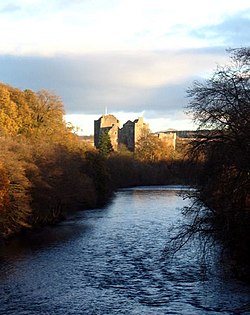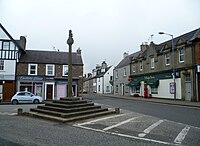Doune
| Doune Gaelic: An Dùn | |
| Perthshire | |
|---|---|
 Doune Castle | |
| Location | |
| Grid reference: | NN726016 |
| Location: | 56°11’24"N, 4°3’11"W |
| Data | |
| Population: | 1,635 (2001) |
| Post town: | Doune |
| Postcode: | FK16 |
| Dialling code: | 01786 |
| Local Government | |
| Council: | Stirling |
| Parliamentary constituency: |
Stirling |
Doune is a burgh in Perthshire, within the parish of Kilmadock and mainly within the area surrounded by the River Teith and Ardoch Burn.
Doune has a small primary school with 163 pupils on the roll (November 2012), drawn from a catchment area which extends outside the town, especially to the north.
History

The town is dominated by Doune Castle, built in the late-14th century. Architecturally it is a mixture of fortress and manor house.
Charles Stuart the Young Pretender ("Bonnie Prince Charlie") passed through Doune in 1745.[1]
Doune was once famous for its manufacture of pistols, but this eventually ceased due to the competition of manufacturers in, for example, Birmingham where production was cheaper. Today, these pistols are collected and can be found in major museums, including the Museum of Scotland in Edinburgh. Allegedly a Doune pistol fired the first shot of the American War of Independence.[2]
Throughout the parish the names most often met with are Campbell, Stewart, Ferguson, Morrison, McAlpine, McLaren, MacDonald, Mathieson and Cameron.[3]
Land east of Doune was owned by the Stirling of Keir family (who still own a lot of the land around Keir House, but sold the house itself), and the current owner of the Keir Estates is the politician, Archie Stirling. One member of the family was David Stirling, founder of the SAS, and he is memorialised at a monument on the Keir land near Doune known as the Hill o' Rou.
Archaeology
Doune is well known for its Pistols and Roman remains, but the Doune area has been inhabited a lot longer and many burial mounds and standing stones supporting this are clearly evident and plentiful. To the rear of Doune where the Ponds and the Doune Riggs housing development now sits was known locally as Currachmore. This area contained the bluebell wood, an area popular with walkers, it was also part of the Doune Golf course. This area was quarried and the sand coming from here was used in the construction of Longannet power station. Also lost to the quarrying was a mound measuring 150 yards long, 100 yards wide and 30 feet high, known locally as the Round Wood. At the time of quarrying, a stone cist or coffin was uncovered and in it were remains of a small boy aged 6, with a small stone axe. He was identified as one of the Beaker people of the early Bronze Age 1800 BC.[4]
The remains of a Roman fort were excavated by Headland Archaeology.[5] Three ditches and the base of a rampart were investigated comprising part of the defense works. Set into the back of the rampart five circular stone bread ovens were located. Running behind the ovens a gravel track was interpreted as the intervallum way (one of the internal roads of the fort). The foundations of a building that it is thought served as the fort’s hospital were also uncovered. Fragments of samian ware and amphorae were recovered dating to the Flavian period and the first Roman incursion into Scotland (from AD 79 to mid AD 80s).
Folklore
Doune has tales of fairies; one such place is Ternishee, this is the name of a little wood east of the Annat chapel, above Doune Lodge, a mile and a half from Doune. Its name comes from the Gaelic "tir na sídhe" meaning land of the fairy. Fairy dancing parties were known of on the Fairy Knowe, a hillock on the right bank of the Ardoch Burn, half a miles east of Doune. Also near the Bridge of Teith, on the low road to Callander, there is a burial mound called Tullochanknowe, this is a favourite haunt of the Fairies as every child of the district will know.[6]
Other information
Doune Speed Hillclimb is the most prestigious hillclimb course in the land, and hosts a round of the British Hill Climb Championship each year.
The town used to be served by Doune railway station.
A few scenes from the film Monty Python and the Holy Grail were filmed at Doune Castle.
Outside links
References
- ↑ MacKay, Moray S.(1953). Doune Historical Notes, p. 35. Forth Naturalist and Historian Board ISBN 0950696250.
- ↑ Doune Pistol Factory
- ↑ MacKay, Moray S.(1953). Doune Historical Notes, p. 102. Forth Naturalist and Historian Board ISBN 0950696250.
- ↑ MacKay, Moray S.(1953). Doune Historical Notes, p. 97. Forth Naturalist and Historian Board ISBN 0950696250.
- ↑ Moloney, C. (1999) 'Doune Primary School, Doune (Kilmadock Parish), Roman Fort, Discovery and Excavation in Scotland p. 87
- ↑ MacKay, Moray S.(1953). Doune Historical Notes, p. 104 - 105. Forth Naturalist and Historian Board ISBN 0950696250.